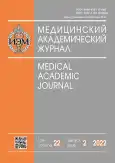Cellular immune response to combined DNA-protein constructs carrying SARS-CoV-2 antigens
- Authors: Zadorozhny A.M.1, Borgoyakova M.B.1, Starostina E.V.1, Karpenko L.I.1
-
Affiliations:
- State Research Center of Virology and Biotechnology “Vector”, Federal Service for Surveillance on Consumer Rights Protection and Human Well-being
- Issue: Vol 22, No 2 (2022)
- Pages: 177-181
- Section: Conference proceedings
- Published: 06.11.2022
- URL: https://journals.eco-vector.com/MAJ/article/view/108654
- DOI: https://doi.org/10.17816/MAJ108654
- ID: 108654
Cite item
Abstract
BACKGROUND: One approach that makes it possible to create vaccines relatively quickly and inexpensively is the creation of DNA vaccine constructs. They are of particular interest for the prevention of COVID-19, as they induce both types of immune response – humoral and T cell. Previously, we have created two DNA vaccines based on the pVAX vector: one encodes the full gene of the S protein of the SARS-CoV-2 virus, the second only encodes the receptor-binding domain (RBD) of the S protein of the SARS-CoV-2 virus. Next, the “naked” DNA was wrapped in a polycationic polyglucin-spermidine complex conjugated with the RBD protein. The resulting combined DNA-protein constructs were named CCV-RBD and CCV-S, respectively.
AIM: To investigate the induction of the T cell immune response of the developed combined DNA protein candidate vaccines in an animal model.
MATERIALS AND METHODS: BALB/c mice were immunized with constructs CCV-RBD and CCV-S, after which their spleens were removed from which splenocytes were isolated. The cellular response was assessed by the ability of splenocytes to secrete cytokines in response to stimulation with viral peptides. The intensity of the response was recorded using the intracellular cytokine staining (ICS) method using flow cytometry.
RESULTS: BALB/c mice were immunized twice with an interval of three weeks with a dose of 100 μg of DNA (8 animals per group): 1) CCV-RBD 2) CCV-S and 3) intact animals. It has been shown that both T helper lymphocytes (CD4+) and cytotoxic lymphocytes (CD8+) of animals immunized with CCV-S and CCV-RBD respond with the release of cytokines in response to stimulation with viral peptides.
CONCLUSIONS: In the case of CCV-RBD, a trend towards a higher response in both CD4+ and CD8+ was observed compared to the CCV-S group. Possibly, this difference may be due to more efficient synthesis of the RBD protein than the S protein, providing a DNA vaccine.
Keywords
Full Text
About the authors
Aleksey M. Zadorozhny
State Research Center of Virology and Biotechnology “Vector”, Federal Service for Surveillance on Consumer Rights Protection and Human Well-being
Author for correspondence.
Email: zadorozhnyy_am@vector.nsc.ru
Intern Researcher
Russian Federation, Koltsovo, Novosibirsk RegionMaria B. Borgoyakova
State Research Center of Virology and Biotechnology “Vector”, Federal Service for Surveillance on Consumer Rights Protection and Human Well-being
Email: borgoyakova_mb@vector.nsc.ru
ORCID iD: 0000-0002-0768-1561
Scopus Author ID: 57221732585
Junior Research Associate
Russian Federation, Koltsovo, Novosibirsk RegionEkaterina V. Starostina
State Research Center of Virology and Biotechnology “Vector”, Federal Service for Surveillance on Consumer Rights Protection and Human Well-being
Email: starostina_ev@vector.nsc.ru
ORCID iD: 0000-0002-1733-9524
Cand. Sci. (Biol.), Research Associate
Russian Federation, Koltsovo, Novosibirsk RegionLarisa I. Karpenko
State Research Center of Virology and Biotechnology “Vector”, Federal Service for Surveillance on Consumer Rights Protection and Human Well-being
Email: karpenko@vector.nsc.ru
ORCID iD: 0000-0003-4365-8809
Scopus Author ID: 7005000410
Dr. Sci. (Biol.), Assistant Professor, Leading Research Associate
Russian Federation, Koltsovo, Novosibirsk RegionReferences
- Morens DM, Taubenberger JK, Fauci AS. Universal Coronavirus Vaccines — an urgent need. N Engl J Med. 2022;386(26):297–299. doi: 10.1056/NEJMp2118468
- Lumley SF, O’Donnell D, Stoesser NE, et al. Antibody status and incidence of SARS-CoV-2 infection in health care workers. N Engl J Med. 2021;384(6):533–540. DOI: 0.1056/NEJMoa2034545
- Hartenian E, Nandakumar D, Lari A, et al. The molecular virology of coronaviruses. J Biol Chem. 2020;295(37):12910–12934. doi: 10.1074/jbc.REV120.013930
- Borgojakova MB, Karpenko LI, Rudomjotov AP, et al. Immunogenic Properties of the DNA Construct Encoding the Receptor-Binding Domain of the SARS-CoV-2 Spike Protein. Mol Biol (Mosk). 2021;55(6):987–998. (In Russ.). doi: 10.31857/S0026898421060045
- Borgoyakova MB, Karpenko LI, Rudometov AP, et al. Self-assembled particles combining SARS-CoV-2 RBD Protein and RBD DNA vaccine induce synergistic enhancement of the humoral response in mice. Int J Mol Sci. 2022;23(4):2188. doi: 10.3390/ijms23042188
Supplementary files








